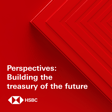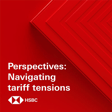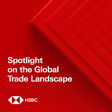Become a Creator today!Start creating today - Share your story with the world!
Start for free
00:00:00
00:00:01

Innovation and digitisation of trade: transforming the future of trade finance – from HSBC Asia Pacific Trade Exchange
The COVID-19 pandemic has accelerated the trend of global digitisation, where technology is playing a pivotal role in adjusting to a “new normal”. This is not an option any more. Listen now to HSBC and different industry experts including Boston Consulting Group, SRF Limited, Tradeshift, Walmart China.
This episode was recorded in February 2021 from the HSBC Asia Pacific Trade Exchange. During the event, we have explored the current landscape of trade, shared ideas, and discussed what the future holds alongside thought leaders from across the world.
For more information about anything that you have heard in this podcast and to view related content, click here
Hosted on Acast. See acast.com/privacy for more information.
Transcript
Introduction and Episode Setup
00:00:00
Speaker
This is HSBC Global Viewpoint, your window into the thinking, trends and issues shaping global banking and markets.
00:00:09
Speaker
Join us as we hear from industry leaders and HSBC experts on the latest insights and opportunities for your business.
00:00:18
Speaker
A heads up to our listeners that this episode has been recorded remotely, therefore the sound quality may vary.
00:00:24
Speaker
Thank you for listening.
Panel Introduction
00:00:30
Speaker
Good afternoon, ladies and gentlemen.
00:00:32
Speaker
I have a distinguished and diverse group of panelists representing corporates, fintechs, and consultants, and they're joining us from right across the globe.
00:00:41
Speaker
So we have Susan from Walmart in Shenzhen, China, Sukhand from BCG in the UK, and Christian from TradeShift, who's normally based in San Francisco, but is joining us from Guatemala.
00:00:53
Speaker
So truly a global panel crossing across different time zones.
00:00:59
Speaker
I'm going to let my panelists introduce themselves in just a couple of minutes.
HSBC Navigator Survey Insights
00:01:03
Speaker
But before that, I wanted to set some background to the discussions that we're going to have over the next 40 minutes.
00:01:10
Speaker
So if you could just pull up the slide.
00:01:12
Speaker
Thank you.
00:01:13
Speaker
So HSBC runs the Navigator survey across 10,000 businesses in almost 40 markets that span across our global network in the trade corridors we cover.
00:01:26
Speaker
So this represents a really rich and varied source of inputs directly from corporate businesses.
00:01:32
Speaker
I'm going to use three findings from the 2020 survey to really set the framework for our discussion today.
00:01:39
Speaker
So firstly, not surprisingly in this environment, over 90% of businesses have concerns with the resiliency and transparency of their supply chains.
00:01:51
Speaker
Half of the respondents said that they see digital and tech as an immediate and necessary priority in this particular context and to fix some of these concerns.
00:02:03
Speaker
Secondly, higher growth firms, so firms with high growth rates, are making most of their sales through online models and with the number of digital natives doubling,
00:02:15
Speaker
Without a doubt, this boom in e-commerce and the changing business model, the pace is going to gather even more momentum.
00:02:23
Speaker
And while overwhelmingly, the third point, while overwhelmingly businesses believe better sustainability transforms to more sales, however, there still remain concerns on the lack of transparency and the ability to monitor supplier performance against their sustainability requirements.
00:02:42
Speaker
So that, I think, just helps us set the context.
00:02:45
Speaker
And if we can take off the slide.
00:02:47
Speaker
But what we want to cover today really is a rich range of topics on weather and how technology is helping businesses.
Technology and Business Adaptability
00:02:57
Speaker
And we want to cover within that a few things.
00:03:00
Speaker
So the adoption to the new operating models, can technology and how can it play a role there, given the present environment challenges and opportunities, but also respond to changing consumer behaviors.
00:03:14
Speaker
The second is, how can tech help businesses create the networked and digitally connected supply chains they need for better agility, transparency and traceability?
00:03:25
Speaker
And finally, this often cliched point about can we really literally physically converge the physical and the financial supply chains and the advent of platforms, aggregators who have now got scale like never before, what kind of opportunities can that help unlock?
00:03:43
Speaker
And across all of these, we'd like to kind of also see how the financial service partners and fintechs are responding.
Panelist Introductions
00:03:51
Speaker
So with that, I'm going to start with asking my panelists to introduce themselves and we're going to go from east to west.
00:03:58
Speaker
So Susan, maybe if you could start with you.
00:04:01
Speaker
Okay.
00:04:02
Speaker
Hello everyone.
00:04:03
Speaker
This is Susan Wu from Walmart China.
00:04:05
Speaker
I'm taking charge of Treasury Department in my company.
00:04:09
Speaker
In the past one year, one of my focus is developing a supply chain financing program together with Bens and FinTech company.
00:04:18
Speaker
Looking forward to this panel session.
00:04:21
Speaker
Thank you.
00:04:23
Speaker
Thank you so much, Susan.
00:04:24
Speaker
Thank you for joining us.
00:04:25
Speaker
Suken, you're in London.
00:04:27
Speaker
Good morning, Vinay.
00:04:28
Speaker
Good morning, everybody from London.
00:04:31
Speaker
My name is Sukhand Ramachandran.
00:04:32
Speaker
I'm a senior partner with the Boston Consulting Group.
00:04:36
Speaker
And as part of my role, I lead wholesale banking in Western Europe and the topics around trade globally for BCG.
00:04:42
Speaker
Happy to be here, share my perspectives and have a good afternoon.
00:04:47
Speaker
Thanks, Sukhand.
00:04:48
Speaker
Christian, all the way from Guatemala.
00:04:51
Speaker
Well, thank you so much.
00:04:52
Speaker
I'm CEO, co-founder and chairman of TradeShift, a cloud computing fintech platform that helps large Fortune 500 companies and large companies in general connect with their suppliers around the world in a digital way to do all of the trade main voices to purchase orders to working capital.
00:05:09
Speaker
become more than 100 plus countries and work with some of the largest companies.
00:05:14
Speaker
So these topics that you have today are of course of great importance to us, everything from resilience to ESG.
00:05:18
Speaker
Thanks, Christian, and thank you all for joining us today.
Technology in Retail at Walmart China
00:05:21
Speaker
I'm going to start now with my first question to the panelist, so maybe Susan.
00:05:25
Speaker
So with the shift from offline to online models, what organizational challenges have emerged and what role do you see technology playing in this transformation for Walmart?
00:05:38
Speaker
Okay, this is a good question to retail industry.
00:05:42
Speaker
There are always new challenges facing business as retail industry rapidly change due to technology evolution, especially the street from offline to online.
00:05:54
Speaker
Heightened customer expectation, massive advancement in technology and the rise of the omitranial commons are
00:06:02
Speaker
just a few of trends shaping the world of retail.
00:06:07
Speaker
In China market, most retailers now are becoming only China retailers.
00:06:13
Speaker
Retailers are finding technology solutions to catch up the trends and lead a transformation.
00:06:20
Speaker
Technology is playing a critical role in the transformation.
00:06:26
Speaker
Taking Walmart China as an example, in order to improve the customer payment experience, Walmart China worked with tech companies to upgrade the post-tech system, introduce self-checkout machine,
00:06:40
Speaker
scan and go payment time, which are providing customers more friendly payment time and reducing tax scenarios during COVID period.
00:06:51
Speaker
And also Walmart developed our own application to operate online business several years ago.
00:06:59
Speaker
In order to grow faster, we also build a partnership with leader marketplace JD
00:07:06
Speaker
and opened a Walmart flagship store on JD platform and developed a new business with Jindong for Jindong Dao Jia.
00:07:17
Speaker
The customer can do online booking and offline store pick up and deliver to the customer.
00:07:25
Speaker
I think this is typical omit channel retailer strategy.
00:07:28
Speaker
In brief, technology made retail transformation easier.
00:07:34
Speaker
Yeah, thank you.
00:07:36
Speaker
Thanks, Susan.
Digital Supply Chain Transformation
00:07:37
Speaker
That's fascinating to really hear that transformation at Walmart.
00:07:40
Speaker
Thank you for sharing that.
00:07:42
Speaker
So maybe I'll come over to you, Christian.
00:07:44
Speaker
What digital platforms that you see at TradeShift yourself are emerging, the solutions that are emerging to help with this transformation that Susan mentioned and to manage businesses?
00:07:57
Speaker
this shift on this adoption of online and also as we go through that it'll be good to also hear your thoughts on the inherent vulnerabilities in supply chains and you know it comes to fore with the potential of disruptions that we you know that the audience felt you're going to be seeing almost once every three and a half years so be good to get your your your sense on the digital platforms and then how you know to shift to the online mode but also then how does it address the vulnerabilities
00:08:24
Speaker
Yeah, no, thank you.
00:08:25
Speaker
I'll try to see if I can cover all of that.
00:08:27
Speaker
That was a broad question, but I think it's a really important one.
00:08:31
Speaker
So first to summarize the first part, the transition in supply chains we're seeing is actually exactly the same as we've seen as consumers.
00:08:38
Speaker
As consumers, we have over the last 15 years moved from on-premise to cloud and then to network.
00:08:44
Speaker
And we tend to think about cloud as the end stage, but as consumers, it's pretty clear that we don't have a single application today that's not networked.
00:08:52
Speaker
So the idea for five minutes we used to upload our photos to Google Picasso and just store them in the cloud, but then we got Instagram and Facebook and we shared them with everyone and the idea that we would just upload them to cloud without sharing them is gone.
00:09:05
Speaker
In enterprise it's exactly the same, right?
00:09:07
Speaker
And the reason for this is pretty simple, which is cloud computing drives down the cost of connectivity.
00:09:13
Speaker
So the easier it is to connect companies, the cheaper it is to connect companies, the more companies will be connected.
00:09:19
Speaker
And inversely, the more companies that are connected, the more valuable they'll be in being connected.
00:09:24
Speaker
So I think we're really seeing kind of an inflection point for what I would call fully digital supply chains.
00:09:31
Speaker
Most customers, we go out and help digitize and bring the supply base online.
00:09:36
Speaker
They come from supply chains that still are running on email, fax, PDF, spreadsheets.
00:09:42
Speaker
So you think in 2021, it's digital, it's not.
00:09:46
Speaker
And it's actually incredible to see that transition happening.
00:09:48
Speaker
COVID has massively accelerated it because a lot of suppliers are nervous about getting paid.
00:09:53
Speaker
So we see that as a massive, massive accelerator.
00:09:56
Speaker
In fact, when COVID started in March for real, we saw almost a doubling month over month of the amount of suppliers coming online, going from around 20,000 to 40,000 suppliers monthly trying to connect digitally to get paid.
00:10:11
Speaker
So I think we're seeing a real inflection point from offline or from on-prem to cloud to network right now in business.
00:10:21
Speaker
You then asked me about what are some of the disruptions and what are some of the challenges.
Outdated Paradigms and Digital Solutions
00:10:26
Speaker
I think a massive challenge we have is that the main supply chain paradigm that has existed honestly since the 80s has not really taken into account any of our modern realities, right?
00:10:37
Speaker
We essentially globally operate on most of the principles back from the 80s ideas of supply chain, which is lean, which means we operate with as little inventory as we can, as efficient as we can, with as few suppliers as we can.
00:10:50
Speaker
And there's a lot of challenges with that in a modern world.
00:10:53
Speaker
First off, we have few suppliers because it costs a lot of money in an old world to manage a lot of suppliers.
00:10:59
Speaker
Well, in the digital world, it don't cost a lot more to manage a thousand suppliers than ten suppliers.
00:11:04
Speaker
So that sort of is in the past, right?
00:11:08
Speaker
And the second big piece here is that the whole inventory question, I think everybody got a big challenge during COVID, right?
00:11:15
Speaker
I'll just take one example from the UK.
00:11:19
Speaker
The UK spent around $30 billion buying PPE to deal in the hospitals with COVID.
00:11:25
Speaker
Had they bought that PPE one year before, it would cost them $2 billion.
00:11:30
Speaker
And in fact, they wiped out more than 20 years of lean savings in the medical supply chains in one year.
00:11:39
Speaker
So I think one thing we're going to really take a look at is to say,
00:11:42
Speaker
Are these supply chain ideas that we have from the 80s that are built in a world that's extremely stable, had a very sort of set world order, no disruption, really viable in 2021 onwards?
00:11:53
Speaker
Because I don't think the disruption amount is going to go down.
00:11:56
Speaker
I think it's going to go up.
00:11:58
Speaker
um and and just to sort of finalize that thought um you know uh i think we're going to move from what i would say is is probably just in time with sort of been the mantra for 20 years to just in case um the cost of not being prepared is far more uh than having a little bit for instance of excess inventory or a little bit of excess suppliers in your supply base and i'm just a very clear thing right i know you guys have seen that but we've seen that as well
00:12:23
Speaker
suppliers from all over the world or buyers from all over the world reached out to us when COVID hit and said, do you know additional suppliers within this category?
00:12:30
Speaker
Do you know additional suppliers who can do this?
00:12:33
Speaker
And it's incredible to me that some of the largest companies in the world were sort of caught a little bit in a blind spot in such a situation.
00:12:41
Speaker
So I think there's going to be a big, big reckoning in how we run these supply chains in the future.
00:12:48
Speaker
Thanks.
00:12:49
Speaker
Thanks, Rishan, for that.
00:12:49
Speaker
And thanks for covering both the questions.
00:12:51
Speaker
And I think we'll come back to the supply chain resiliency and the point around, I think you said, from just in time to just in case and the number of suppliers.
00:12:59
Speaker
But just sticking with the first thematic of, you know, the B2B trading platforms and the move to digital.
00:13:06
Speaker
So I'm very keen to get your insights as you work with several corporates and banks on
00:13:11
Speaker
on how are you seeing these trading platforms disrupting the legacy models and accelerating the shift to digital?
00:13:19
Speaker
Let me refer to about two or three different data points that I've actually shared.
00:13:22
Speaker
I think your survey itself said something around sort of fast growth.
00:13:26
Speaker
I think Christian referred to the network effects.
00:13:28
Speaker
And let me borrow from one of your colleagues who quite eloquently described to me the fact that, you know, if you go back into the 18th and 19th centuries,
00:13:38
Speaker
to do what Christian talked about as networking.
00:13:40
Speaker
They came to ports.
00:13:41
Speaker
They went to Hong Kong, they went to Shanghai, they went to Rotterdam, they went to London.
00:13:45
Speaker
These were the big ports of those days, right?
00:13:47
Speaker
And that's where they went.
00:13:48
Speaker
I think if you look at the current century, actually this decade in particular,
00:13:54
Speaker
that port has become the sort of the platforms of the world, right?
00:13:57
Speaker
The digital world is where the ports are.
00:13:59
Speaker
These are the digital ports of commerce of the current world, right?
00:14:03
Speaker
And I think that the network effects of going to a port, which was physically in the old world about connecting to who my buyers might be, figuring out how do I do my logistics effectively,
00:14:15
Speaker
has now become electronic.
00:14:17
Speaker
And we're getting these electronic platform providers integrating all of these services, not necessarily manufacturing all of them.
00:14:23
Speaker
They're not creating it.
00:14:24
Speaker
They're just connecting it up and then making it available for businesses to interact and do commerce more effectively.
00:14:30
Speaker
So the decade of the 20s will see an acceleration of that.
00:14:35
Speaker
It will see the networking to happen very much in a digital world.
00:14:38
Speaker
Now, the interesting thing for me is you can have a debate on how
00:14:43
Speaker
rapidly would traditional supply chains, which have been very much, as Christian said, large to large with at least an intermediary aggregating a lot of small into at least large enough chunks to make this just-in-time model work, how disaggregated will that get?
00:14:59
Speaker
My sense is I think we're going to see a little bit of a balancing act over the next four or five years.
00:15:03
Speaker
It won't be a full trip to just in case.
00:15:05
Speaker
Again, we won't want to get in there, but I think digital allows two things.
00:15:08
Speaker
I think
00:15:09
Speaker
it'll create what we call the physical twin.
00:15:11
Speaker
It's a digital world will start tracking more telemetry as to what is happening, where is the inventory, what's the state of transit, when is it likely to be delivered.
00:15:21
Speaker
So more transparency around transitions will allow that trade-off between how much do I need to keep as inventory, how much is actually in transit, and how much is in manufacturing, and therefore see the whole flow much more dynamically, much more on a real-time basis.
00:15:35
Speaker
I think that information exchange will what create the trade-offs
00:15:39
Speaker
between do I need to keep a lot of stock?
00:15:41
Speaker
Do I need to actually have diversification around where my stock comes from?
00:15:45
Speaker
And or how ready am I actually to be resilient to any disruptions?
00:15:50
Speaker
So the digital world enables the creation because I can put data visualization on top of the physical world.
00:15:58
Speaker
I can create more networks digitally.
00:16:01
Speaker
And more importantly, I can actually share that information.
00:16:03
Speaker
Therefore, it's more valuable for other people.
00:16:07
Speaker
Thanks.
00:16:07
Speaker
Thanks, Yukant.
00:16:08
Speaker
I think that's fascinating how the increased transparency will help companies and businesses get more efficient with managing to do the digital models and the points around inventory.
00:16:19
Speaker
Maybe it's a good time for another question for the audience, if we could put up the second poll.
00:16:24
Speaker
And here we really wanted to understand, while you're dealing with both your supply side and your sell side or your distribution chains,
00:16:34
Speaker
What are probably some of the biggest challenges or even opportunities, you might say, that digital solutions could help you solve?
00:16:41
Speaker
So if you could choose one of those four options, so is it about sales channel management, so you're able to actually accelerate sales or go direct to consumer without necessarily going to resellers?
00:16:54
Speaker
Is that of critical importance?
00:16:57
Speaker
Or is it the second one where it helps you with your procurement and invoicing process
00:17:02
Speaker
and helps resolve some of the challenges around that?
00:17:05
Speaker
Is it going to do more with the diversification of supply chains?
00:17:09
Speaker
Is that a bigger pain point that you need to kind of address, especially given what we've talked on the disruptions?
00:17:15
Speaker
And then finally, is it around the shipping or the logistic challenges that at this present moment, you know, how kind of constraining the cost of containers, et cetera, have been?
00:17:26
Speaker
So really keen to understand what are some of the challenges, opportunities you see, and when the results are ready, if they could be flashed up.
00:17:33
Speaker
Again, just a general reminder for any questions that you have for the panelists, if you could raise them through your screen.
00:17:39
Speaker
We'll just give it a second to get the summary of what you see are the greatest challenges that digital solutions could help your organization solve.
00:17:58
Speaker
All right.
00:17:58
Speaker
That's really interesting.
00:18:00
Speaker
So over 30 percent, the majority feel that the challenges around managing shipping and logistics, I presume that's just the ability to book shipping logistics, the ability to get the right price is quite fundamentally challenging.
00:18:14
Speaker
And I suppose that then helps.
00:18:16
Speaker
That then kind of has an iteration into the negotiations with your buyers and sellers.
00:18:21
Speaker
The second most was a process around procurement and invoicing.
00:18:24
Speaker
So how digitally synchronized that could be.
00:18:27
Speaker
And then supply chain diversification.
00:18:30
Speaker
And then finally, sales channel management.
00:18:32
Speaker
That is really interesting insight.
00:18:35
Speaker
And I'm sure some of our colleagues working in the shipping logistics space will be very interested to see some of that.
00:18:41
Speaker
But let me kind of...
Supply Chain Risk Management and Efficiency
00:18:44
Speaker
come back to kind of Christian around the point that we last left off around disruptions and supply chain resiliency.
00:18:50
Speaker
So maybe, you know, specific to TradeShift, keen to understand, kind of Christian, some of the toolkits, technology systems your company is evaluating or adopting to strengthen the supply chain risk management and transparency for buyers and suppliers that use the TradeShift platform.
00:19:09
Speaker
Yeah, no, so first off, I mean, maybe just to give it a bit of context, we connect around
00:19:14
Speaker
150 of the Fortune 500, probably not a thousand of the largest companies in the world, but around 2 million suppliers globally.
00:19:20
Speaker
And it puts around 500 billion dollars of trade through, right?
00:19:23
Speaker
So we see a pretty big slice of the global trade picture.
00:19:26
Speaker
It's across around 100 countries.
00:19:28
Speaker
And I think I just want to start with a global picture, which is one of increasing complexity across the board.
00:19:34
Speaker
We're not just even talking COVID.
00:19:35
Speaker
We're not just talking China, every single country in the world.
00:19:39
Speaker
There's increasing regulation for supplier compliance, increasing regulation for taxation.
00:19:44
Speaker
We're seeing more and more countries on invoicing having clearance rules where you need to post a copy of your transaction with the government and so on.
00:19:52
Speaker
So just doing business as a baseline has become probably, I would say, 10 to 20x more complex than it were even five or seven years ago.
00:20:01
Speaker
And actually, I don't think there's any path to managing that complexity and not being digital.
00:20:08
Speaker
Because managing that on paper, reading the data fields through a scanner, all of that is just going to be a very, very laborious process, right?
00:20:17
Speaker
So when we talk about working around the diversification and complexity, one of the things we worked a lot on is for companies to understand the supply base a lot better.
00:20:27
Speaker
On average, you know, for some of our largest customers, we onboard to digital around 30,000 to 50,000 suppliers.
00:20:33
Speaker
These are not small numbers.
00:20:35
Speaker
One customer we had in the fast-woman consumer industry, they had in 20 years onboard 1,500 suppliers to digital using 20 different solutions.
00:20:46
Speaker
meaning a very diversified landscape of solutions and data.
00:20:50
Speaker
In six months, we put 26,000 suppliers live for them on the same platform.
00:20:55
Speaker
And then we went and analyzed what suppliers are you actually doing business with?
00:20:58
Speaker
And that was a very different picture of what they thought they were doing business with.
00:21:01
Speaker
It was interesting in itself.
00:21:03
Speaker
We were also able to aggregate a lot of branches of different suppliers, which actually were the same legal entities underneath.
00:21:08
Speaker
So I think just having the ability to have that data on one platform and being able to consolidate and look also allow you to understand the risk.
00:21:16
Speaker
Finally, we can give signals.
00:21:18
Speaker
We don't always understand those signals, but again, some months ago, we saw trade drop to half in Wuhan.
00:21:25
Speaker
We had absolutely no idea of why that was happening.
00:21:27
Speaker
At the moment, come January, we obviously knew.
00:21:29
Speaker
But we were able to give our customers access to these baseline changes in certain regions where they do business.
00:21:37
Speaker
And they can then use their intelligence on the ground combined with other things to figure out what decisions they want to make, right?
00:21:43
Speaker
So I think the sooner and earlier you can react to these things, the better chance you stand, right?
00:21:49
Speaker
And honestly, I think we need to think a lot more about this almost like we do in cloud computing, where we think about cybersecurity, for instance, as a real threat to our network in real time.
00:22:00
Speaker
Everything right now in supply chain is very slow moving.
00:22:02
Speaker
We take a long time to react.
00:22:04
Speaker
We need to take a long time to analyze.
00:22:06
Speaker
And I think in the future, you probably will have built-in plans.
00:22:10
Speaker
That's part of your setup, even on a software level.
00:22:14
Speaker
So how you want to react if you see certain signals happening in your network,
00:22:17
Speaker
That could be currency fluctuations, that could be big changes in logistics prices, or that could just be trade activity moving very dramatically compared to what you think about in a region.
00:22:28
Speaker
And if you don't, I mean, there's going to be big winners and losers for those who can figure that out and those who can't.
00:22:34
Speaker
And again, I probably want to come back to, and this is a little self-serving as I sell to the station,
00:22:39
Speaker
you're going to have very little chance to participate in that game if you don't start with a baseline of digital.
00:22:45
Speaker
And I don't think we're talking about last generation of sort of EDI and legacy technologies, because there's no way you're going to reach 20,000 suppliers with that.
00:22:53
Speaker
You need to really get to that global scale, and that's going to be very, very hard for us out there.
00:23:01
Speaker
Thanks, Tasvishan.
00:23:02
Speaker
So baseline, start with digital, and then I can see you say that from a range of very micro alerts,
00:23:09
Speaker
to more macro insights is one way in which you can kind of improve the transparency and supply chain risk management.
00:23:15
Speaker
So maybe building on that point, and I think, you know, your earlier comment on kind of the digital transparency to help manage the physical supply chains, how do you see kind of corporates managing these emerging challenges and solutions around resiliency in supply chains?
00:23:30
Speaker
Yeah, I think I would say it's not even just corporate, right?
00:23:33
Speaker
I would go all the way on the commercial side, like small to large businesses all have to do it.
00:23:38
Speaker
Of course, the many aggregated up a large corporate will have quite material risks, especially if they've been running a sort of 20 year just in time supply chain and they're starting to see disruptions play out in multiple different places in their supply chain, right?
00:23:50
Speaker
So yes, the impact on large corporates is material, but it's equally true for small businesses.
00:23:55
Speaker
So we just concluded a series of research in ASEAN and South Asia.
00:23:58
Speaker
And one of the interesting insights from small businesses was where we were talking about logistics.
00:24:04
Speaker
I mean, like the...
00:24:05
Speaker
both the buyer and the supplier want transparency on who the logistics provider is, who's being used by the supplier to actually ship the goods, what's the certainty around that?
00:24:16
Speaker
And if you look at a lot of the small businesses, they are quite dependent on intermediaries who may not necessarily be fully plugged into the digital value chain.
00:24:24
Speaker
So to your question on what's the solution space and what should we think about from a digital perspective, I think
00:24:30
Speaker
There is almost a role here for large corporates to try and democratize access to some of that sort of digital solution.
00:24:35
Speaker
It actually will help them if they know that their suppliers, especially the ones who are smaller businesses who can't afford it, but have some very good specific tools and capabilities that in the supply chain is necessary for the large corporate to actually democratize access to some of those, right?
00:24:48
Speaker
So it's not easy and feasible for...
00:24:51
Speaker
all the small businesses to go and connect them into a myriad variety.
00:24:55
Speaker
And I think Christian's very right.
00:24:56
Speaker
It's not gonna be some dominant single solution space.
00:24:59
Speaker
It's gonna be a series of platforms.
00:25:00
Speaker
It's gonna be a series of interconnectivity points from a digital perspective.
00:25:05
Speaker
And you can't expect small businesses to connect to all of them.
00:25:08
Speaker
I think what will happen is corporates, especially the larger ones, will become the magnetic poles which will attract some of these platforms, which will attract some of the suppliers, and you will evolve into a digital standard.
00:25:19
Speaker
And then that then becomes a new norm around which other people can build.
00:25:24
Speaker
And to the first discussion, I would say there is a role for digital B2B platforms.
00:25:28
Speaker
in terms of creating data standards.
00:25:30
Speaker
There's a role for larger corporates in just sort of democratizing how they want to interact with suppliers.
00:25:36
Speaker
And I think there's a role for small businesses to actually be more digitally engaged as a means to provide transparency into the supply chain.
00:25:42
Speaker
I think everybody has a role to play here.
00:25:45
Speaker
Digital just happens to be the mechanism by which the information flow happens, which it reflects
00:25:49
Speaker
the real world physical supply chains.
00:25:51
Speaker
And then you understand when you look at the data where the disruptions might be happening, you can look for pre-warning signals.
00:25:58
Speaker
You can look for resilient ways to alternate supply paths, et cetera.
00:26:02
Speaker
Now, in the middle of it all, I think if you're a middleman who has no digital capability, I think you're likely to be the person losing that.
00:26:08
Speaker
But in a way, that's possibly the right thing for us to do going forward.
00:26:12
Speaker
Can I just attach a very brief comment to that, Vinay?
00:26:15
Speaker
Because I think you said something that was so spot on to kind of
00:26:18
Speaker
For instance, when we designed TradeShift, one of the very first design conversations we made was it had to be absolutely free for suppliers.
00:26:26
Speaker
And at the time, it was a completely radical concept.
00:26:28
Speaker
Everybody else in our industry was charging suppliers.
00:26:31
Speaker
But if your goal is to digitize your supply chain, if you put a cost in there for your supply base, you just created friction on your main goal.
00:26:40
Speaker
And I really think we have 20 years of technology
00:26:44
Speaker
in procurement and elsewhere that's tried to do one thing, which is to push the supplier as far away as possible, and to create a smaller needle hole as possible.
00:26:51
Speaker
You don't want to touch the supplier, you want to push them away, you want to put them on the other side of a tender portal.
00:26:56
Speaker
I think that needs to change.
00:26:57
Speaker
I think we need to think about it as part of our workflow.
00:27:00
Speaker
I think we need to think about them as part of our platforms, as part of our data process.
00:27:04
Speaker
And we completely need to inverse that.
00:27:06
Speaker
And that's a big part of the design criteria we put into the Traceship platform.
00:27:09
Speaker
And I think we're pretty excited about, I would say, that direction from some of the leaders in the space that are completely reversing direction, saying, okay, we don't need to push the supply away.
00:27:19
Speaker
We actually need to pull them in.
00:27:21
Speaker
And two, we cannot create friction by putting cost in front of them because it's actually our advantage that they're connected and digital and communicating with us as much as possible.
00:27:31
Speaker
Thanks.
00:27:31
Speaker
Very great question.
00:27:32
Speaker
Thanks.
00:27:32
Speaker
Thanks, Sukhan.
00:27:33
Speaker
Thanks, Krishan.
00:27:34
Speaker
Susan, so we've now talked a lot about kind of the business models, the offline to online.
00:27:39
Speaker
We've talked about the supply chain resiliency.
Evolution of Trade Finance in Digital Era
00:27:42
Speaker
We're going to now come to trade finance and how does this all overlay with it?
00:27:46
Speaker
So in your view, how do you find trade finance solutions need to evolve in the digital world?
00:27:52
Speaker
And what is really this new kind of normal for us?
00:27:57
Speaker
I think in China as part of the new normal, there has been a focus drive across industry on digitalization and platformization of chip chain ecosystem.
00:28:10
Speaker
Last year, Walmart China started to use the external think tech company to set up
00:28:16
Speaker
of platform for supply chain finance.
00:28:19
Speaker
Our thousands of suppliers and Walmart can have procurement data exchange in the platform, which is open to and can be accessed by banks for the credit evaluation and supply finance accordingly.
00:28:34
Speaker
HSBC China has been working with us to implement this project.
00:28:39
Speaker
It's not been a straightforward journey.
00:28:43
Speaker
We together studied the chain flow now, flow, data points of finance requirements and process optimization for better surprise user experience.
00:28:54
Speaker
Recently, we've seen suppliers being onboarded and started utilizing the facility.
00:29:01
Speaker
It's just a star.
00:29:03
Speaker
But we are confident that this would scale up very soon.
00:29:07
Speaker
HBC China has also discussed with me about the idea of having a string line working capital solution, integrating the pre and post-shipping financing lab to cover the end to end supply chain needs of suppliers.
00:29:26
Speaker
With the experience and synergy established, we are keen to move forward together to build a healthy and sustainable supply chain ecosystem.
00:29:39
Speaker
Thanks, Susan.
00:29:39
Speaker
And I think that's really interesting, right, as I think suppliers need financing earlier in the working capital at the pre-shipment stage and how the transparency and data we've talked can enable that happen and then integrate it across the post-shipment.
00:29:53
Speaker
So that's fascinating.
00:29:54
Speaker
On that same topic and what both Sukhan talked about, the different client personas,
00:29:59
Speaker
And Christian talked about, you know, how the SME supplier
SMEs and Digital Solutions in Global Supply Chains
00:30:04
Speaker
should be treated.
00:30:04
Speaker
I wanted to ask the next question to our audience.
00:30:07
Speaker
So if we can put up the third poll, I think, you know, it's obvious that I think, you know, it's fact that SME, small and medium enterprises across the world make up for almost 98 percent of corporates that trade globally.
00:30:21
Speaker
I just wanted to get your sense of what percentage of your organization's supply chain comprises these SMEs.
00:30:28
Speaker
And we've got ranges from 0 to 25, all the way from 75, all the way to 75 to 100.
00:30:33
Speaker
So if you could choose that, and I will let the event organize put up the results.
00:30:39
Speaker
I think the reason we're asking that question is exactly what was discussed before.
00:30:43
Speaker
We know that SMEs are pivotal to trade, but we also believe that
00:30:47
Speaker
that they're disproportionately being treated or being impacted by disruptions, right?
00:30:52
Speaker
And, you know, even without some of the pandemic challenges, it has been quite challenging for them to trade internationally.
00:30:59
Speaker
And we'll talk a little bit about, you know, some of the roles that digitization can play around that.
00:31:05
Speaker
And Susan's talked to that with the Walmart China partnership with HSBC.
00:31:09
Speaker
But if you could have the results of the poll when ready, that'd be great.
00:31:20
Speaker
Apologies for the overhead noise of the planes coming.
00:31:23
Speaker
They're all flying in from Asia this early in the morning.
00:31:25
Speaker
So you go straight over my head.
00:31:27
Speaker
So sorry for the background noise.
00:31:33
Speaker
Just waiting on the results to see what percentage of your SMEs constitute in your supply chains.
00:31:42
Speaker
So about 50 to 75 percent is by far the largest you can see there.
Banks, Fintechs, and Corporate Partnerships
00:31:49
Speaker
So that's 34 percent of you have
00:31:54
Speaker
between 50 to 75% of SMEs make up your supply chain.
00:31:59
Speaker
So it's a significant chunk of your supply chain is comprised of SMEs.
00:32:04
Speaker
And I think to that extent, what we just discussed with Susan's engagement on an example of kind of making sure they get finance earlier in the working capital cycle is quite critical, right?
00:32:16
Speaker
Susan, just moving us on, maybe the next question back to you again is what kind of corporate bank partnerships would you be willing to form or you see already emerging in this space?
00:32:27
Speaker
And do you see a role for non-bank fintechs in this particular domain and area?
00:32:34
Speaker
This is an interesting topic.
00:32:36
Speaker
An ideal corporate bank partnership would be able to bring long-term and sustainable value to both and also the whole value
00:32:46
Speaker
a chain of corporate business, including supply chain stability and resilience.
00:32:52
Speaker
Walmart globally launched supply chain finance project in 2017, which is a sustainability platform to encourage and track 1 billion metric tons of greenhouse gas emission reductions within our supply chain by 2030.
00:33:12
Speaker
To better support and encourage our supplier collectively joined Project Jigerton, HSBC developed a unique tiered supply chain pricing model tiered to our suppliers' sustainability rating so that the more they achieve, the better finance rate they can enjoy.
00:33:35
Speaker
As to FinTech part, in China, we do observe that FinTechs have been more and more actively participating into the coq-ban relationship, especially in the supply chain business.
00:33:50
Speaker
Some of them take the lead to set up a supply chain finance platform involving both corporate and banks, and some of them provide a tailor-made solution to the corporate banks to build up the supply chain infrastructure.
00:34:08
Speaker
Taking back Walmart China, again, as an example, many Walmart suppliers may expect assets to bank financing leverage buyer support from Walmart.
00:34:19
Speaker
As I mentioned earlier, last year we stepped into implementation of digital platform divided by fintech companies together with HBC and banks and other banks and support our suppliers financing.
00:34:35
Speaker
We are looking forward to having more suppliers on board Eastern to benefit from this partnership program.
00:34:44
Speaker
Our ambition is to achieve a win-win-win, three wins for all participants on the program.
00:34:52
Speaker
Thanks, Susan.
00:34:53
Speaker
That's a very good example, like you best said, win-win-win across it.
00:34:57
Speaker
Just in the interest of time, I know you've only a few minutes left, but one of the three questions we set ourselves up was around the ESG objectives and sustainability, which Susan has given a great example of at Project
ESG Objectives and Supply Chain Management
00:35:08
Speaker
Gigaton.
00:35:08
Speaker
Maybe Sukhan and Christian, starting with you, Sukhan, how do you see technology helping in real terms, getting that transparency that's required that help clients like Walmart track the sustainability across their supply chains?
00:35:21
Speaker
So, Vinay, I'll come at it from two specific points I want to learn.
00:35:24
Speaker
I think we often think about sustainability very much in the climate action space.
00:35:29
Speaker
But if you look at it from a UN SDG point, there are 16 other goals.
00:35:33
Speaker
And when we think about ESG, we think about all of the 17 UN Sustainable Development Goals.
00:35:37
Speaker
That includes elimination of poverty, child labor, that includes diversity and a whole bunch of other factors.
00:35:44
Speaker
So, yes, you can focus in on one of the ones that everybody's focused on this year in particular, especially in London with COP26 happening in Glasgow, which is climate change.
00:35:53
Speaker
But I think if you think about sustainability in the more holistic sense, it's about tracking those metrics.
00:35:59
Speaker
It's about knowing that
00:36:02
Speaker
the full supply chain.
00:36:02
Speaker
And when I say full supply chain, it's not just one hop.
00:36:04
Speaker
It's like, how do I go five, six, seven, eight hops to origin of goods, do the traceability of origin, figure out how well against the 17 UN sustainable goals the whole supply chain is operating.
00:36:18
Speaker
What can you do to influence that?
00:36:20
Speaker
And how do you make sure that everybody is aware of the fact that it's a holistic transition we as a society are doing.
00:36:26
Speaker
And this is not just simply about economics.
00:36:28
Speaker
This is actually good societal impact, which drives better economics for everybody and makes the planet a better place to be.
00:36:35
Speaker
digital traceability across multiple parameters is what will enable that.
00:36:40
Speaker
And I think the fact that you have multiple goals that you need to solve for makes digital absolutely critical to how to do this rather than just focus on greenhouse gas emissions as a single point.
00:36:52
Speaker
Thanks, and Christian's the same question.
00:36:54
Speaker
I mean, from a trade ship perspective, you know, the toolkits or the partnerships that will kind of accelerate the embracing of ESG objectives.
00:37:03
Speaker
I think what's crucial here is first you've got to know, right?
00:37:05
Speaker
If you have an organization buying, you've got to know what is the data.
00:37:08
Speaker
And to represent that data, you need to track it on a transactional level.
00:37:13
Speaker
It's not just enough to have a survey of supplier, right?
00:37:15
Speaker
You actually need to know what's the footprint of any given transaction.
00:37:19
Speaker
And we have apps today on the Tracer platform that allow you to track the carbon footprint.
00:37:23
Speaker
You can look at the shipping distances, measures, all of those things.
00:37:26
Speaker
We have anti-slavery apps that go look at, you know, goods procured, what are the risks of that?
00:37:31
Speaker
I think what's much more interesting is to say that's knowing, but how can we then make it effective?
00:37:36
Speaker
I mean, how do you cause change on the supplier side?
00:37:39
Speaker
I mean, supplier behavior and bad supplier behavior comes because most likely of cost.
00:37:46
Speaker
And I think one thing that we've been experimenting with a number of our customers is very interesting is to tie the development goals to financing structures.
00:37:56
Speaker
you can think about supply chain finance as more than just a strategic tool to collapse the payment term, but you can also look at the cost of supply chain finance as an incentive to do the right thing.
00:38:06
Speaker
And a really good example could be around, let's say, the Pormall supply chain in Southeast Asia, where, to be frank, a lot of that has to do with economics.
00:38:16
Speaker
So I think, you know, we've got to think realistically, we've got to combine what's going on in supply chain finance and the new fintech models we can put there with the data that we have from the
00:38:26
Speaker
insights and then say to the supplier, if you give us a full audit or access to how you produce this, guess what?
00:38:31
Speaker
You're going to get a lower rate of capital.
00:38:33
Speaker
Then you have a real carrot that actually moves something rather than saying you've got to do it because we say so.
00:38:39
Speaker
Great.
00:38:40
Speaker
Thanks.
00:38:40
Speaker
Thanks, Akhan.
00:38:41
Speaker
Thanks, Rishan.
00:38:42
Speaker
So just, you know, I'm going to take a question now from the audience, right?
00:38:46
Speaker
So I think I'll try and set up the answer because I want to sum up what you all said, but also give an HSBC perspective.
00:38:52
Speaker
And then I will come to you for a quick one minute kind of summary of what you think.
00:38:57
Speaker
So the question is...
Future of Trade Digitalization
00:38:58
Speaker
Will 2021 be the year that trade becomes more comprehensively digitized?
00:39:04
Speaker
And from an HSBC perspective, I'll say kind of just probably break it up in three parts.
00:39:09
Speaker
I think the first is our clients are increasingly using digital tools to communicate and instruct us.
00:39:17
Speaker
So our digital penetration rates were in the mid 20 percent a few years ago, just about two to three years ago.
00:39:24
Speaker
And that adoption was gradual towards digital, but the pandemic has just exponentially grown that and now 70% of all communication, whether applications for trade loans, letter of credit, advisors, is all happening through digital channels.
00:39:39
Speaker
So fair to say that I think by 2021, we'll have bulk of our communication with our clients digitized.
00:39:45
Speaker
So that's part one.
00:39:47
Speaker
The middle stream is about the trade documentation that's out there, physical bills of lading, all the paper that's out there.
00:39:54
Speaker
And that journey to digitization, my kind of honest answer to that is probably is going to take another two to three to four years to get scale.
00:40:02
Speaker
But we are seeing the adoption of blockchain and digitization of trade and electronic BLs
00:40:08
Speaker
again ramping up very very actively but it's not at scale as yet so that's probably a little bit longer journey but the third area of digitization is probably the most exciting is what you've all talked about susan you know so kind of question is how we can use digital information and data to change the way we lend to our clients and their buyers and suppliers so we've done a lot of that by lending on different platforms
00:40:33
Speaker
using data to make decisions in a matter of few hours or days, whether it is to take weeks or months.
00:40:39
Speaker
And that's something that I think is probably the most exciting area of digitization.
00:40:43
Speaker
And we'll see a lot of that happen in 21.
00:40:45
Speaker
That is the new way of lending.
00:40:47
Speaker
So the answer is probably we'll get there somewhere in 21 across themes one and three.
00:40:53
Speaker
But moving all the paper that's in trade, I think is probably going to be more challenging.
00:40:57
Speaker
But maybe I'll start with you, Sukhan, to see what your perspective on that is very briefly.
00:41:02
Speaker
I think it's in the nuance in the question, right?
00:41:05
Speaker
Is this the end of digitization?
00:41:07
Speaker
Heck no.
00:41:08
Speaker
I think this is, I would say the start of a journey.
00:41:10
Speaker
I think what has happened in 20, which is we're going to make 21 and forward different is a realization that information is critical in moments of disruption, right?
00:41:22
Speaker
And I think so what will happen is there will be more information which will get digitized and there will be more willingness to share that information where required with the relevant parties.
00:41:32
Speaker
But I think as you would do with any element of tokenization, what you don't want is a million different tokens which don't make sense to other people other than the ones who create the tokens, right?
00:41:41
Speaker
So it's a very simple fact of digitization is happening.
00:41:45
Speaker
Now we need to make sure that there is interoperability
00:41:47
Speaker
and shareability of that information where people can make sense of it.
00:41:50
Speaker
Otherwise, we'll have the Tower of Babel in digital, right?
00:41:53
Speaker
And I think we just need to make sure we avoid that and we're getting that sort of digital connectivity and common standards.
00:42:00
Speaker
I think I expect this year is where we will drive some more standards, more commonality and more digitization.
00:42:07
Speaker
It's not anywhere near the end of the journey.
00:42:09
Speaker
I would say this is the beginning of the end, but it's nowhere near the end.
00:42:12
Speaker
Thanks.
00:42:14
Speaker
And Susan, very briefly, and then Christian.
00:42:18
Speaker
Okay, in brief from corporate view of that for the digitalization and performance, how we use the digitalization and performance to benefit for the company and our clients and suppliers and how the efficiency we can achieve that.
00:42:37
Speaker
So in brief, we continue to search new tech to join our process, including supply chain or other procurement or other something like that.
00:42:51
Speaker
So we're not only using for supply chain financing, but we're also using for the tech digitalization to help to form our future process.
00:43:02
Speaker
Just like that.
00:43:03
Speaker
So from corporate view of that, we need to think the value being to a company and being to our stakeholders.
00:43:14
Speaker
Thanks, Susan.
00:43:15
Speaker
Christian?
00:43:17
Speaker
Yeah, no, I think maybe I want to nuance it a little bit differently.
00:43:20
Speaker
I think, yes, 2021 is also going to be a year of massive digitalization.
00:43:25
Speaker
But I think one thing we've got to nuance and really focus on is what kind of digitalization
00:43:30
Speaker
I mean, my Nokia 3210 30 years ago was digital.
00:43:35
Speaker
And we see a lot of companies who are still deploying, honestly, systems that are 20 or 30 years old in the architecture.
00:43:42
Speaker
And I'm afraid that they're going to be multiple of generations behind in how things are moving right now.
00:43:49
Speaker
And I think one big trade I would keep an eye on is, you know, for instance, classic procurement technology most companies use today is honestly just a digitalization
00:43:58
Speaker
of what used to be a pay-back catalog.
00:44:00
Speaker
It's not different from your Sears catalog 70 years ago, just in electronic form.
00:44:05
Speaker
I think we're going to see a massive switch to B2B marketplace.
00:44:08
Speaker
It's already happening.
00:44:09
Speaker
Amazon is coming in from below.
00:44:11
Speaker
We're seeing in the top, you're going to have multi-buyer, stakeholder marketplace.
00:44:14
Speaker
It's a very different technology set than classic procurement.
00:44:18
Speaker
There's going to be a lot of players who are not set up to that.
00:44:19
Speaker
We don't even understand what's going to happen there because they've gone down the classic procurement route.
00:44:24
Speaker
I think if you look at, for instance, AP automation, e-invoicing, right?
00:44:28
Speaker
You can have a strategy where you try to deal with everything that comes into you and hits you.
00:44:32
Speaker
You can try to scan it.
00:44:33
Speaker
You can try to digitize it.
00:44:34
Speaker
But actually, that is just sort of what I would call dumb digitalization, right?
00:44:40
Speaker
If you put in a network, if you put in smart pipes, you can actually sort of validate most of those transactions before they even get traded out on the supplier side.
00:44:48
Speaker
You can check for VAT, compliance, all of these things, right?
00:44:52
Speaker
So I think, you know, we are going to continue to digitize.
00:44:54
Speaker
We digitize for 50 years now.
00:44:57
Speaker
But I think what is going to matter really a lot, lot more is what kind of digitization we want to put in place.
00:45:01
Speaker
And if there was one thing I would ask everyone to put an eye on is what's happening in the network space.
00:45:07
Speaker
It's no mistake that Microsoft bought LinkedIn some years ago because they understand that we're moving from SaaS standalone to network SaaS.
00:45:15
Speaker
It's no mistake that this year or last year,
00:45:18
Speaker
Salesforce, they bought Slack.
00:45:20
Speaker
It's exactly the same transition, right?
00:45:22
Speaker
So I think I really would... So sorry, Christian.
00:45:27
Speaker
We're out of time, Christian, but thank you for that insight.
00:45:29
Speaker
That was really... So sorry to cut you off.
00:45:31
Speaker
Thank you, all of the panelists.
00:45:33
Speaker
Thank you for listening today.
00:45:34
Speaker
This has been HSBC Global Viewpoint Banking and Markets.
00:45:39
Speaker
For more information about anything you heard in this podcast or to learn about HSBC's global services and offerings,
00:45:46
Speaker
please visit gbm.hsbc.com.

















